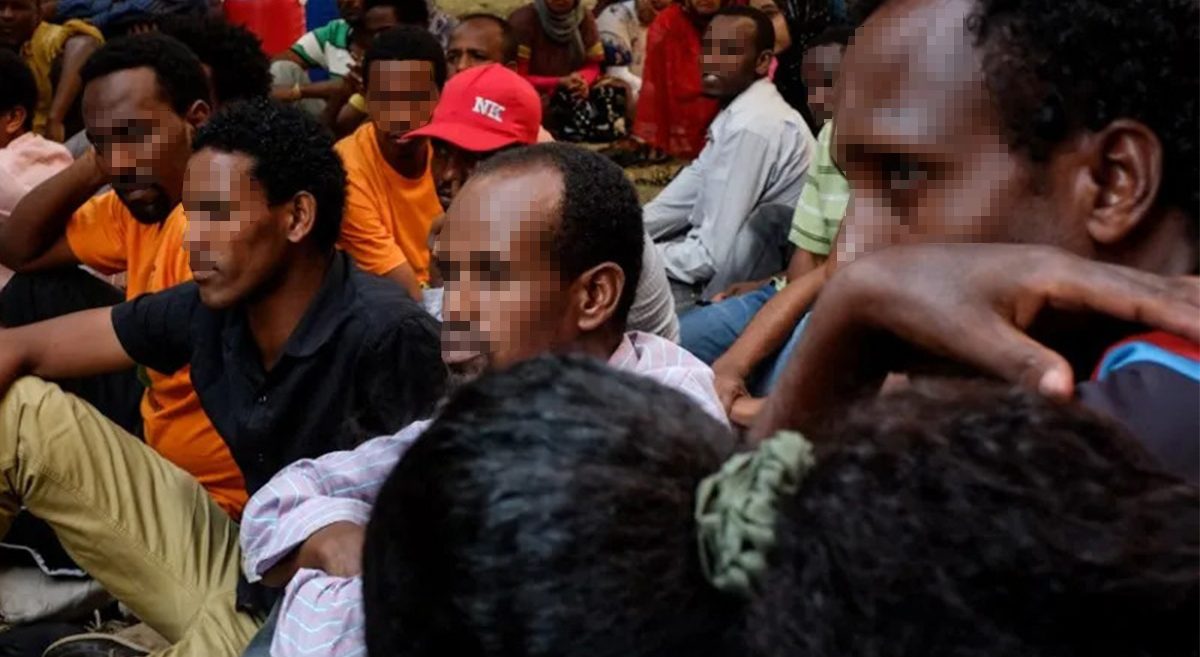Analysis: Tragedy struck Ethiopia, again. “We are dealing with a different scenario”

Hayalnesh Gezahegn and Zecharias Zelalem
(Additional reporting from Bileh Jelan)
Addis Abeba, October 28/2019 – “I was on my way to my father’s flour mill on Wednesday morning [October 23] when a small group of young men and women gathered up not far from where I was and began marching toward the city center chanting ‘down, down Abiy’, ‘Jawar is our hero’ and other slogans,” said Habiba Abdulkadir, a resident of Bale Robe city in Bale zone of Oromia regional state. “I didn’t know what triggered the gathering as they overtook me and I simply went to my work.”
The small protest Habiba saw in the morning gathered momentum and “spread into various parts of the city during the course of the day,” she said, “in the afternoon, most of the city businesses were shut down; schools have released students before noon and residents have largely deserted the city centers to be at home.”
Wednesday came to an end “without major incident”, but “nothing prepared me for what happened the next two days on Thursday and Friday,” Habiba said during a phone interview with Addis Standard, her voice breaking into tears and shiver.
From Ambo to Dodolla & Bale Robe, from Bishoftu to Adama, Asella and Ziway, in Oromia regional state, and Harar in Harari regional state, as well as Dire Dawa chartered city cities were engulfed first with anti-Prime Minister Abiy Ahmed and pro Jawar Mohammed protests. These protests were followed the next day by security crackdown, violent confrontations and group infighting in many of the cities and towns.
By the government’s own admittance, 67 people have been killed and hundreds more displaced as the protests degenerated into riot and sheer violence. In what has become a terrible scourge across the country in recent months, attackers on a wanton desire to cause harm and violence, in most cases moving in groups have targeted victims belonging to various ethnic and religious groups.
Unlike in the past, this latest tragic episode erupted after Jawar Mohammed, executive director Oromo Media Network (OMN) and prominent activist posted information in his Facebook page on Tuesday night that his security detail were told “to pack their stuff and leave the compound quietly without alerting me.”
But that was just the immediate trigger.
***
There has been a prior buildup of tension to the three day’s protest, rampage, and violence.Weeks before Ethiopian social media space was flooded with gruesome pictures of victims, of funerals, of road blockages, inflammatory posters and book burning, tensions were running high in various places in Oromia regional state and in Addis Abeba particularly following this year’s Irreecha holiday, which was officially celebrated in Addis Abeba for the first time in modern Ethiopian history.
According to accounts of more than a dozen interviewees who spoke to Addis Standard from different cities, the cause of this tension, which, like many things in today’s Ethiopia, began as a social media warfare, was a speech delivered by Shimelis Abdissa, vice president of Oromia regional state at the eve of the celebrations. The proliferation of social media confrontations that followed this speech have translated into actual tensions particularly among two underground groups in Adama, according to an eye witness who spoke to Addis Standard.
“In the last two weeks, there were three near violent confrontations in Adama Kebelle 02 between groups calling themselves “Ye Nazareth sim asmelash committee [a committee to return back the name of Nazareth – from its current name Adama] and other groups calling themselves “Qeerroo for Adama,” a resident of the area who want to remain anonymous fearing for her safety told Addis Standard from her sister’s house in Addis Abeba. “Each group were provoking each other by removing symbols and signposts from Bajajs, pols, walls and other places,” she said. “We were living under the shadow of angry young men and women who have nothing happening in their lives other than provoking one another,” she said.
Commander Diriba Alemayehu, a police officer in Adama, admitted the trend and made reference to “we have knowledge that several groups are being organized in the city,” but declined to comment on any specific group.
In its wake, the three days violence spread throughout the city like a bush fire and left not only scores dead, but a trail of property destruction. More than 40 people were also wounded and more than 20 private business properties were damaged, including more than 13 private and commercial cars. Damages also included Africa Flour Factory PLC, and Brothers Biscuit Factory. A mosque in Ganda Hara area in Bole sub-city, in western part of the city was also vandalized and its properties looted.
Although the two groups above are the ones our interviewee mentioned, she said these are but only the two. “The city is becoming home to increasing numbers of groups and counter groups being organized along ethnic, religious and political ideologies. They are just like dynamites awaiting for the perfect time to go off at any given moment.”
Adama is one of the cities that suffered the death of 16 civilians in the three days’ violence. In addition to the death, a community of internally displaced people who are resettled in the northern outskirt of the city were targeted. They are IDPs who were resettled there in the wake of the Somali-Oromia conflict which killed hundreds and displaced more than 1.2 million civilians. They have been a target of repeated violence similar like this one in the past.
***
Further down in south east Addis Abeba, in Dodolla and Assasa in West Arsi zone of Oromia regional state, tensions between various groups organized similarly along different political and religious sections has been simmering particularly since the Ethiopian New Year, a senior official in West Arsi Zone peace and security department told Addis Standard. “We have seen an unprecedented uptick in such behaviors since the New Year celebrations,” he said, adding the police have made a few arrests following violent confrontation involving two such groups in Assasa,Adaba and Kofelle in the “second week of October.” “We are dealing with young people organized along different political and religious sections; groups are being organized over free apps such as WhatsApp and Telegram, making our limited and, frankly, non-exiting capacity to handle such things. It is making violence an easy thing to organize; it needs a vast amount of resource, expertise and political commitment to tackle,” he said, “we are dealing with a different scenario.”
The three days’ violence in Dodolla, which has intensified on Friday afternoon, has left at least 14 people dead and thousands forced to leave their homes and sheltered in churches and Mosques seeking safety; the victims were buried in Muslim and Christian cemeteries.
Tensions may not have been as visible and confrontations as violent as other parts of Oromia regional state, but in the town of Sebeta, located in Oromia Special Zone Surrounding Finfinne, some 20 km south west of Addis Abeba, hundreds of displaced members of the Gamo ethnic group are sheltered at a compound in the town’s Welete Selassie district. In a violence reminiscent to last year’s Burayu killings where the minority ethnic Gamo civilians were subjected for a brutal violence, they were once again singled out for attacks over the course of the three days, which left at least six civilians killed. Hundreds are sheltered in a makeshift camp in the outskirt of Sebeta, where a group of police denied members of Addis Standard staff access to the displaced. Eskinder Terefe of the local outlet Ethio Info shares his similar experience in which one of his journalist colleagues was headed to the makeshift shelter to interview victims but was refused access to them. “Police standing guard told her she couldn’t do any reporting, and that only Oromo media would be allowed in,” Eskinder says.
An emotional burial ceremony was held in Sebeta town on Saturday for two of the victims, one of whom killed while giving service at a protestant church.
***
The funerals from Bale Robe to Dodolla, from Adama to Sebeta have all been replete with anger and raw emotions.
A video which began to circulate online on October 26 and was shared widely appeared to show an unidentified man delivering inflammatory speech to a crowd in the town of Bale Robe, where at least ten people are reported to have been killed and some three thousand are currently sheltered inside churches and mosques. In it the man called for Oromos to no longer work, trade or otherwise deal with “dorzes,” or “neftegnas,” an apparent reference to Ethiopians who are perceived to be outsiders. The two minute and 43 second clip shows the individual who wears a red baseball cap, bellowing his message into a megaphone while the crowd looks on silently. Several attendees can be seen recording the proceedings with camera phones.
The video has gone viral and shocked Ethiopian social media users who are sharing its content as proof that crowds were being coerced into “plotting a genocide.”
Following a request from an individual, Addis Standard was able verify the authenticity of the video from the senior peace and security department officer in West Arsis zone, who is quoted above. According to him, it was filmed on Saturday morning after a funeral of three of the ten civilians killed. The police and city administration authorities were also alerted to the message and efforts are being put in place to denounce the message.
The speaker in megaphone has clearly capitalized on the raw emotions of the day to deliver a ten point message including preventing local from leasing or selling and buying houses and properties with “Neftagnas” and “dorzes”; he also labels anyone who opposes Jawar Mohammed as the enemy of the people of Bale. Furthermore he called for local authorities to be held accountable for the death of the victims on whose burial he took the opportunity to deliver the speech that shocked many. But he claimed the ten points were drafted by the senior community members of the city. Addis Standard could not verify this claim read by a man whose facial features are barely discernible.
But some of the Facebook accounts which disseminated the video appear to be endorsing the message. One of the original uploaders exclaimed that the proposed points in the video “needs to be enforced across Oromia.” However, some of these accounts belong to individuals residing abroad who have refused to return calls from Addis Standard.
***
Uneasy calm has returned to most of the cities and towns which were devastated by the three days tragedy, but residents in Adama, Sebeta, Ziway (where Addis Standard confirmed that three individuals were killed by a security guard at a famous resort), Ambo, Bale Robe and Dodolla say this calm is heavy; the loss of confidence in one’s right to security is weighing heavy on many. Our interviewee from Adama says she plans to “hang around my sister’s place in Addis Abeba for a while although I don’t have leave of absence from my work at a private hotel.”
Habiba from Bale Robe says the feeling of utter devastation and helplessness still overwhelms her. “Can we even say we have a government?” she asks, millions of Ethiopians share her fear.
In a late statement released on Saturday, Prime Minister Abiy Ahmed acknowledged the gravity of the tragedy that struck Ethiopia again under his leadership and promised to “weed out” the perpetrators of this violence. For some, who are demanding Jawar Mohammed to be persecuted for causing it all, it was too little too late. For others, who say only a political solution is the way out, it was yet another remark by a Prime Minister who considers his adversaries as nothing but a chaff who he needed to “weed out.”
For the time being members of Ethiopian defense forces were dispatched to the cities and towns in Oromia which are most affected by the violence, as well as Dire Dawa chartered city, where at least seven people are killed, and in Harar, where a young man was brutally murdered and dumped in a ditch in the first day of the protest. AS




